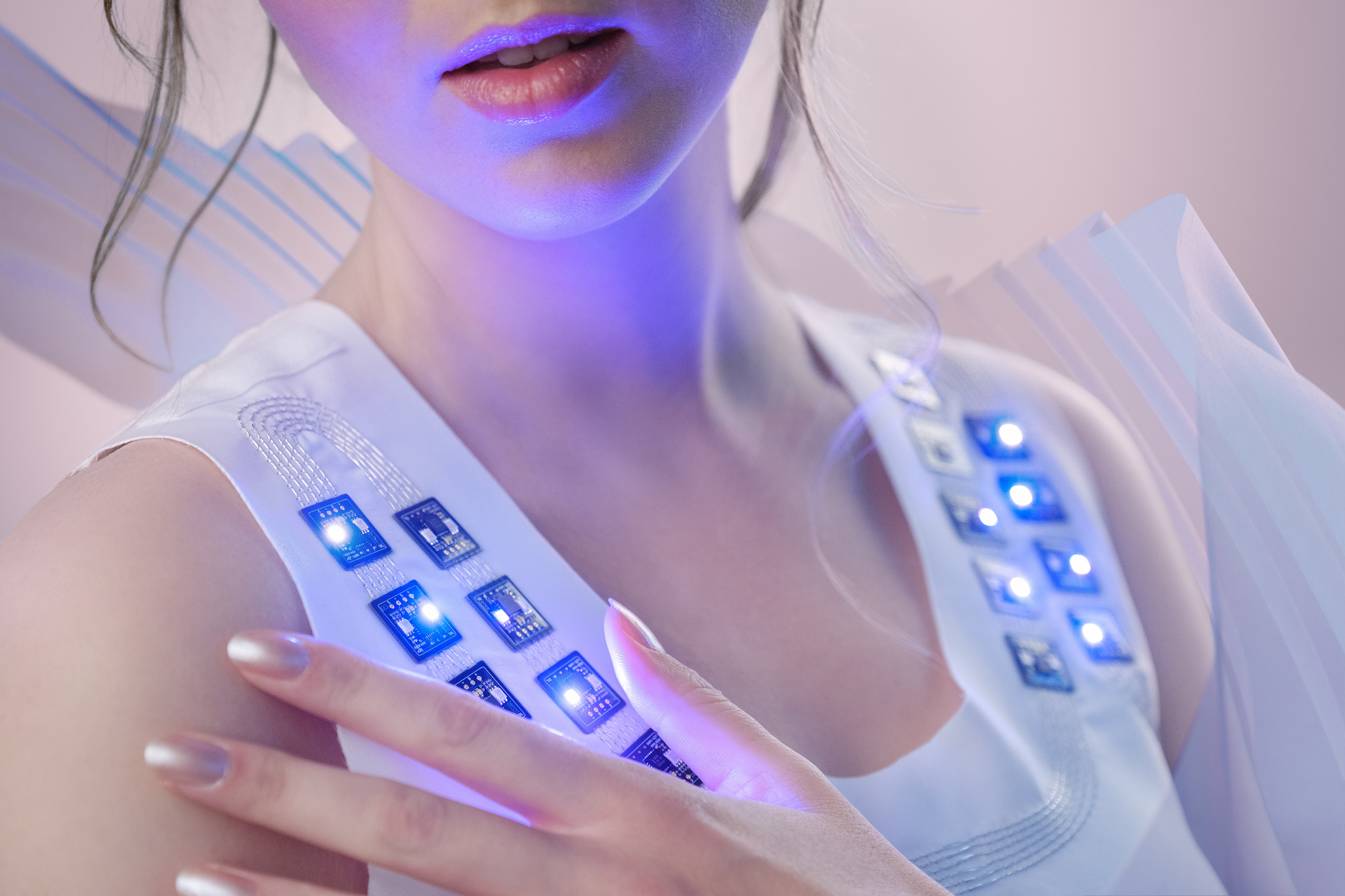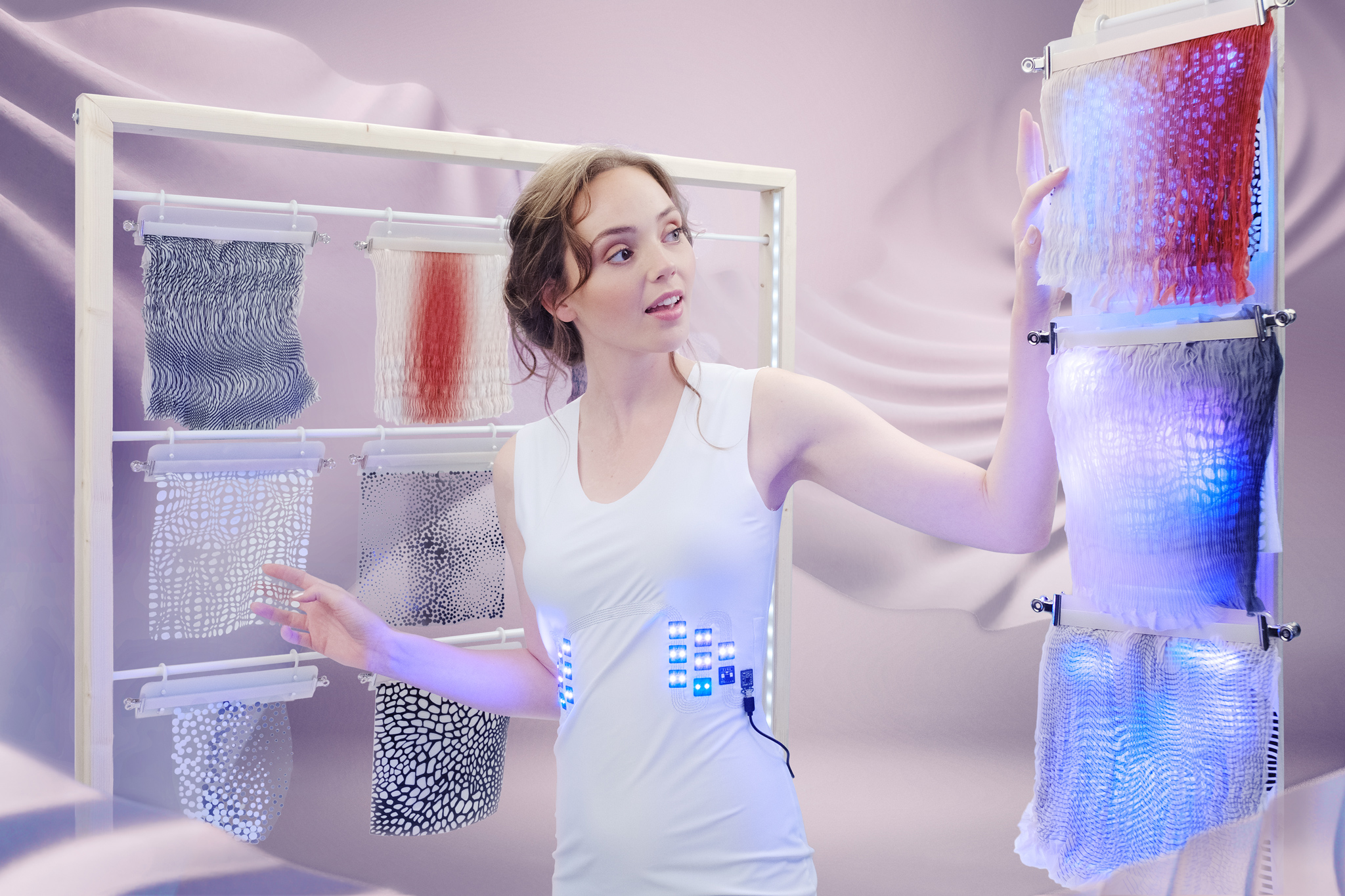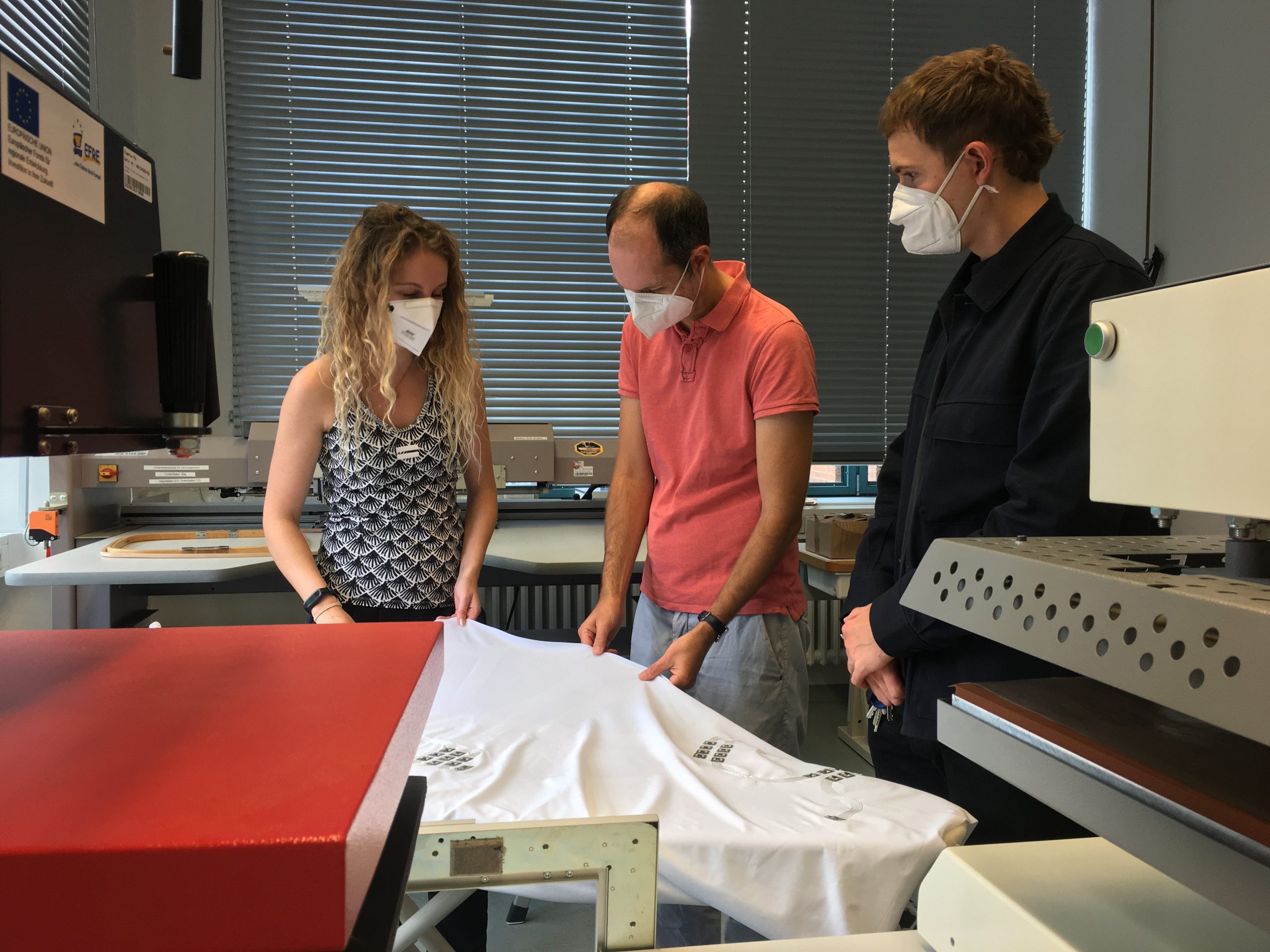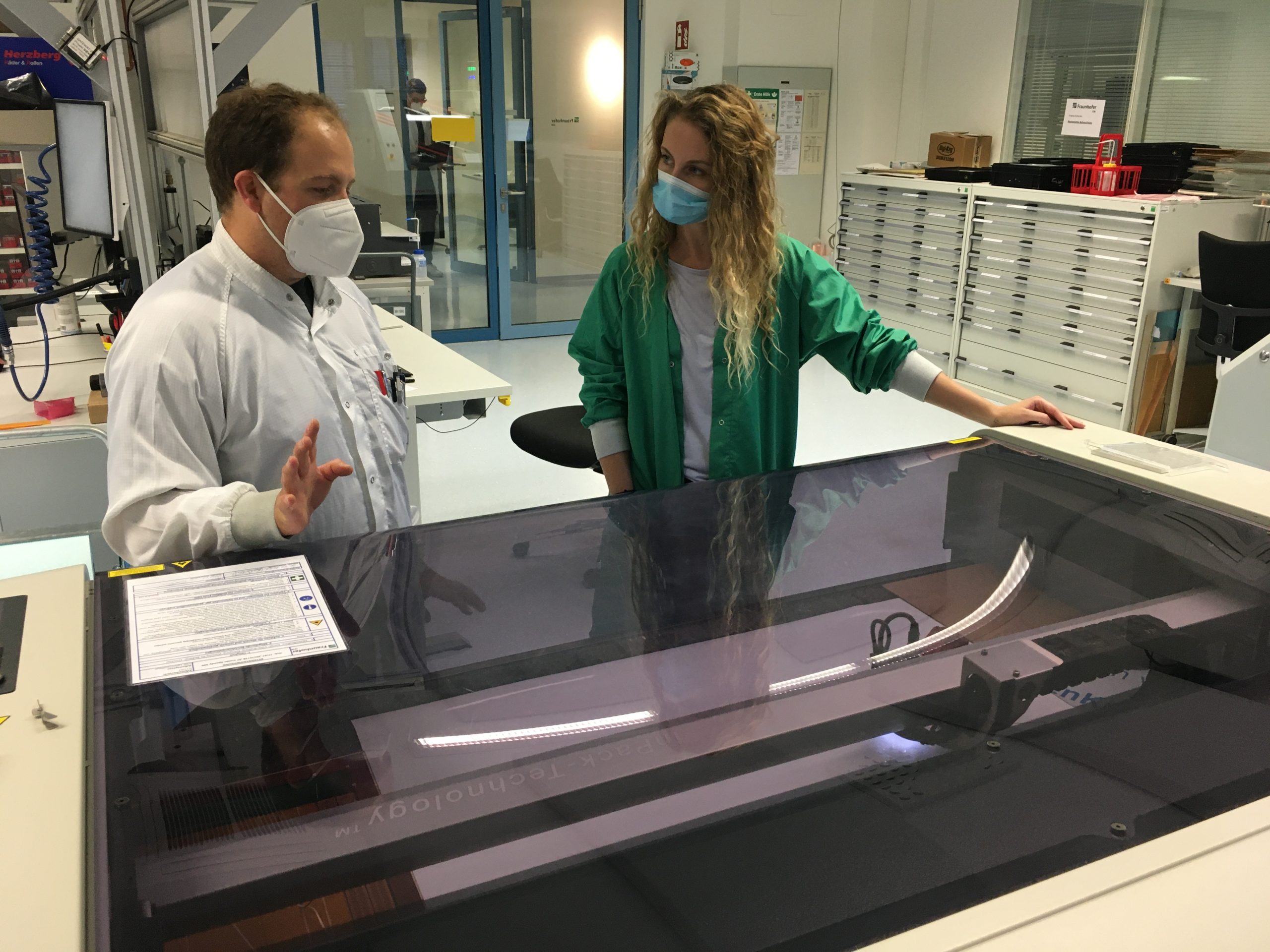“In a world that is becoming smarter every day, it is time that our wardrobe starts to adapt to our needs. Within this interdisciplinary research project, we explored garments that adapt to our practical and social needs. Garments that adapt to how much we want to stand out or be less noticeable. We namely believe that adaptive caring garments will shape our future healthy and sustainable wardrobe.”
Together with nine other designers, Malou won the European Re-FREAM Grant of 2021 and thus was selected as one of the Re-FREAM designers for this year. The grant enabled her to work on the research project Seconds Skins for a period of nine months. In this period, she teamed up in Berlin with a community of scientists and technologists of Re-FREAM. Together they investigated concepts that can change the fashion industry in sustainable and innovative ways.
Re-FREAM
Re-FREAM is a collaborative and interdisciplinary research project, where selected applicants team up with a community of scientists to rethink the manufacturing process of the fashion industry. Re-FREAM is a pillar of the STARTS Programme (Science + Technology + Arts) – an initiative of the European Commission under the Horizon 2020 research and innovation program. For the Second Skins project, Malou Beemer was based in hub Berlin and collaborated with the partners: IZM Fraunhofer, Profactor, EMPA and Wear It Berlin.
The making of Seconds Skins
During the research process, Malou was invited to write about her process, findings and reflections for the Re-FREAM blog. Below you find a brief version of her story, that you can read to develop a deeper understanding of what the Second Skins project encompasses. Links to the full blogposts are included for those who want to learn more.
CONCEPT
Seconds Skins focuses on smart textiles that can adapt to our practical and social needs. This concept emerged from research questions that Malou extensively discusses in the first blog she wrote during the Re-FREAM project period. In this blog, she asks herself:
‘How is it possible that we surround ourselves with passive and polluting garments, while we live in a world that is becoming “smarter” every day?’ She reasons that it would be a great valuable and sustainable solution for the current polluting fast fashion industry, if we could change and customize the colors, patterns, structures and other properties of our clothes, so that we don’t feel the constant need to buy new items anymore. This can truly enhance the life span of the pieces we own.
Another question she discusses in her blog is: ‘How can wearable tech enhance our human communication and social interaction?’ After all, a lot of integrated wearable tech projects are oriented in healthcare, sports and safety. These designs are useful, but often lack a human-centric approach or a focus on human communication. Therefore, with the Seconds Skins project, Malou wanted to investigate the possibilities of developing reactive ‘second skins’ with a central focus on sociology, human behavior and communication.
FUNDAMENT
In her second blog, Malou elaborated on the importance of building a strong foundation for the project. By determining where you want to make an impact, for which specific social environment or context you want to make a difference, which behaviors you want to employ and what will generate and activate change within the garment, you can better define what you are working towards and why and for whom you are doing it.
Investigating these essential questions led her to the main objective for Seconds Skins, namely: developing a wearable that adapts to how much we want to stand out or become less noticeable. You can read Malou’s third blog to find out more about this main goal of the project and the design principles that form the guiding framework of Second Skins.
RESEARCH
During the Re-FREAM project, Malou and her team of experts conducted extensive research on activation methods and responsive, reactive textiles that could be usable for fashion integration. First it was important to gain a good insight into the current state of the art of fashion tech and to find out what responsive and adaptive materials and technologies were already available on the market. Malou’s fourth blog is dedicated to this part of the research and expands on all the current and achievable possibilities of soft actuators, the different actuating methods, effects and movements, the materials and the advantages and disadvantages of these different options.
A substantial part of Malou’s research however is dedicated to envisioning new pathways for fashion tech as such, as she explains in her fifth blog. She states that up until now, high fashion has mainly been valued for its aesthetic and expressive value, while fashion tech has principally been justified by its purpose and function. This is probably the case because the industry of technology is function-driven and therefore, hitherto, the marriage between fashion and technology often led to fashion that is characterized by integrated elements that improve health, comfort or safety.
This is why Malou pleads for the evolution of so called ‘caring garments’, that go beyond the straightforward functions of current fashion tech designs. She instead vouches for designs that focus on more fundamental levels of expression and communication of wearers. Malou believes that the gap between the fashion industry and fashion tech can be closed by a focused approach from the communicational, interactive and expressive perspective. She envisions a future where all these different approaches can seamlessly merch together and fashion can adapt to the practical as well as the aesthetical, interactive and communicative needs.

REFLECTION
In a reflection on the creative process of Second Skins in her sixth blog, Malou tells the most complicated part was finding fitting techniques and materials to generate the organic changes they were looking for in the garment. Furthermore, it was of course very challenging to work on a creative collaboration project during a pandemic. On the one side it was great to discover how easy people worldwide could be connected through innovative digital mediums. But with creative exploration, it is essential to be able to see eachother in real life and to be receptive to all the input around you.
As an international platform that stimulates interdisciplinary collaborations between designers, artists scientists and technologists, Re-FREAM offered Malou the input of all kinds of different angles. The whole experience was all about the fusion of engaged minds, from creatives to scientists. And although this hasn’t happened on the level Malou had hoped for due to the pandemic, the project resulted in several prototypes and a lot of new knowledge that helps Malou to formulate her positioning as a designer and her vision on the future innovation of this field. With the new network and wisdom that was developed within this project, the research can hopefully be continued.
Credits
Concept and Art Director: Malou Beemer / Photography &Image editing: Patrick Klein Meuleman / MUA: Esther de Graaff / Model: Danielle Kroon / Movie production: Halo Media Productions. /
In collaboration with Manon Montant and Thomas Gnahm from Wear It Berlin GmbH, Christian Dils, Max Marwede, Robin Hoske from Fraunhofer IZM Berlin, Agnes Psikuta form Empa, and Pavel Kulha from Profactor /
With external partners: Marina Toeters, Julia van Zilt from ITL Studio, Ward Seetsen, Renée Verberne,
Special thanks to: Isabel Berz, Deborah Allen Rogers, Gérard Stokkink, Troy Nachtigall, Jelske Wilmer, Floortje Peperkamp, Vanessa Rutten, Michelle Hrycauk Nassif, Julie Boehning, Aduen Darriba Frederiks, Kim Hoexum, Marcel Beemer, Hetty Beemer, Camiel Beemer and Egon Notermans.




















